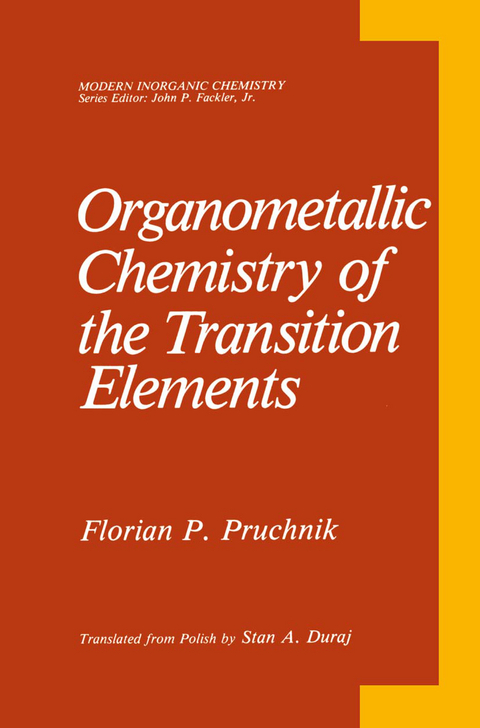
Organometallic Chemistry of the Transition Elements
Seiten
2013
|
Softcover reprint of the original 1st ed. 1990
Springer-Verlag New York Inc.
978-1-4899-2078-2 (ISBN)
Springer-Verlag New York Inc.
978-1-4899-2078-2 (ISBN)
Organometallic chemistry belongs to the most rapidly developing area of chemistry today. This book is based on my lectures concerning basic organometallic chemistry for fourth and fifth year chemistry students and on my lectures concerning advanced organometallic chemistry and homogeneous catalysis for Ph.D.
Organometallic chemistry belongs to the most rapidly developing area of chemistry today. This is due to the fact that research dealing with the structure of compounds and chemical bonding has been greatly intensified in recent years. Additionally, organometallic compounds have been widely utilized in catalysis, organic synthesis, electronics, etc. This book is based on my lectures concerning basic organometallic chemistry for fourth and fifth year chemistry students and on my lectures concerning advanced organometallic chemistry and homogeneous catalysis for Ph.D. graduate students. Many recent developments in the area of organometallic chemistry as weIl as homogeneous catalysis are presented. Essential research results dealing with a given class of organometallic compounds are discussed briefly. Results of physicochemical research methods of various organometallic compounds as weIl as their synthesis, properties, structures, reactivities, and applications are discussed more thoroughly. The selection of tabulated data is arbitrary because, often, it has been impossible to avoid omissions. Nevertheless, these data can be very helpful in understanding properties of organometaIlic compounds and their reactivities. All physical data are given in SI units; the interatomic distances are given in pm units in figures and tables. I am indebted to Professor S. A. Duraj for translating and editing this book. His remarks, discussions, and suggestions are greatly appreciated. I also express gratitude to Virginia E. Duraj for editing and proofreading.
Organometallic chemistry belongs to the most rapidly developing area of chemistry today. This is due to the fact that research dealing with the structure of compounds and chemical bonding has been greatly intensified in recent years. Additionally, organometallic compounds have been widely utilized in catalysis, organic synthesis, electronics, etc. This book is based on my lectures concerning basic organometallic chemistry for fourth and fifth year chemistry students and on my lectures concerning advanced organometallic chemistry and homogeneous catalysis for Ph.D. graduate students. Many recent developments in the area of organometallic chemistry as weIl as homogeneous catalysis are presented. Essential research results dealing with a given class of organometallic compounds are discussed briefly. Results of physicochemical research methods of various organometallic compounds as weIl as their synthesis, properties, structures, reactivities, and applications are discussed more thoroughly. The selection of tabulated data is arbitrary because, often, it has been impossible to avoid omissions. Nevertheless, these data can be very helpful in understanding properties of organometaIlic compounds and their reactivities. All physical data are given in SI units; the interatomic distances are given in pm units in figures and tables. I am indebted to Professor S. A. Duraj for translating and editing this book. His remarks, discussions, and suggestions are greatly appreciated. I also express gratitude to Virginia E. Duraj for editing and proofreading.
1. Introduction to Organometallic Chemistry.- 2. Metal Carbonyls.- 3. Metal-Metal Bonds and Clusters.- 4. Compounds Containing le Carbon-Donor Ligands.- 5. Carbene and Carbyne Complexes.- 6. Compounds Containing Two-Electron ?-Ligands.- 7. Complexes Containing Three-Electron n-Ligands.- 8. Compounds Containing Four-Electron n-Ligands.- 9. Compounds Containing Five-Electron n-Ligands.- 10. Complexes Containing Six-Electron n-Ligands.- 11. Complexes Containing Seven- and Eight-Electron n-Ligands.- 12. Isocyanide Complexes 1. Bonding and Structure.- 13. Application of Organometallic Compounds in Homogeneous Catalysis.- Abbreviations.
| Reihe/Serie | Modern Inorganic Chemistry |
|---|---|
| Zusatzinfo | XVIII, 758 p. |
| Verlagsort | New York |
| Sprache | englisch |
| Maße | 155 x 235 mm |
| Themenwelt | Naturwissenschaften ► Chemie ► Analytische Chemie |
| Naturwissenschaften ► Chemie ► Anorganische Chemie | |
| ISBN-10 | 1-4899-2078-1 / 1489920781 |
| ISBN-13 | 978-1-4899-2078-2 / 9781489920782 |
| Zustand | Neuware |
| Haben Sie eine Frage zum Produkt? |
Mehr entdecken
aus dem Bereich
aus dem Bereich


